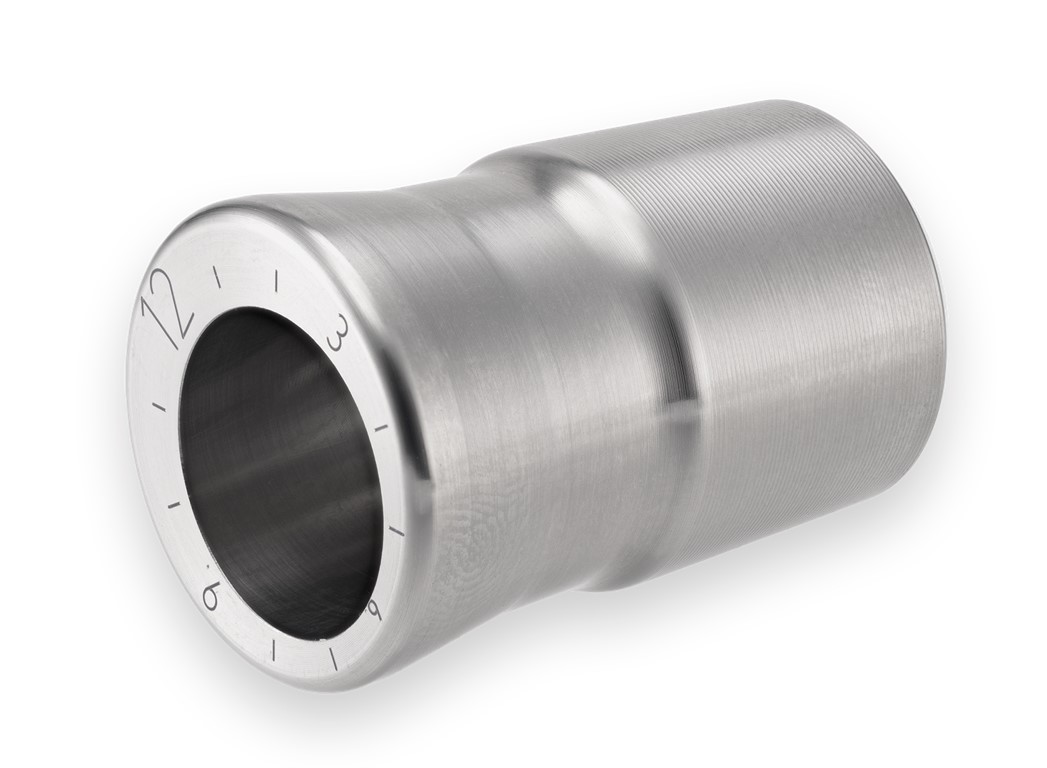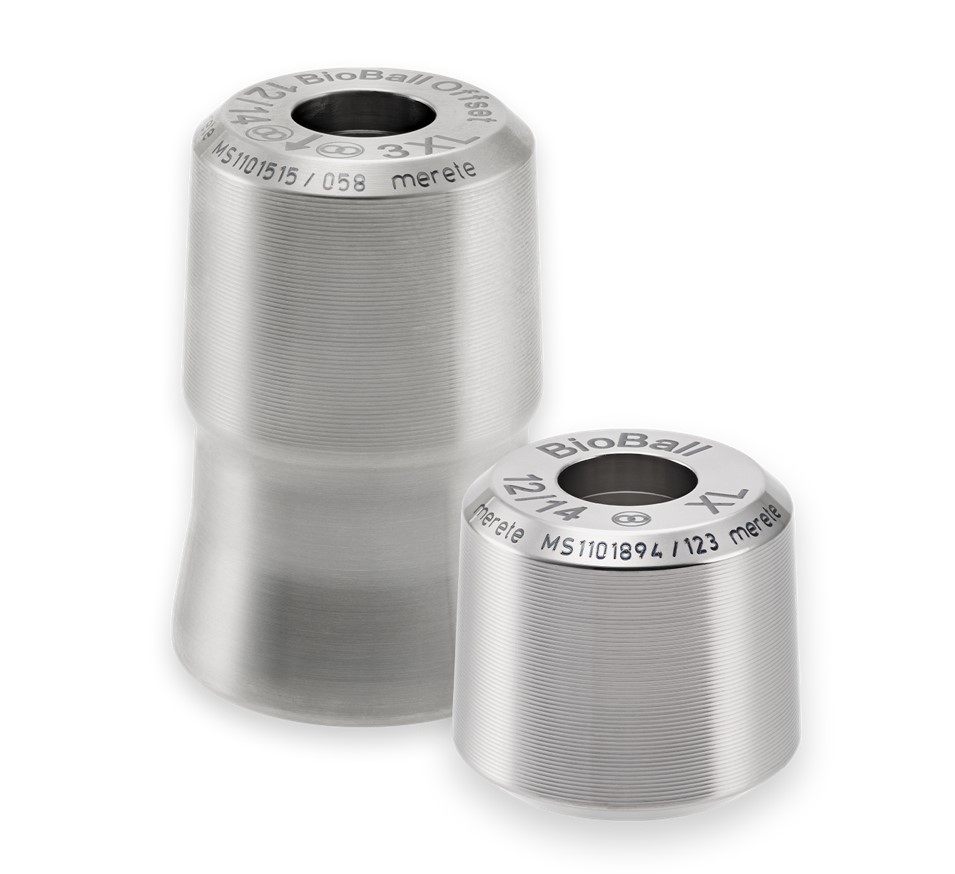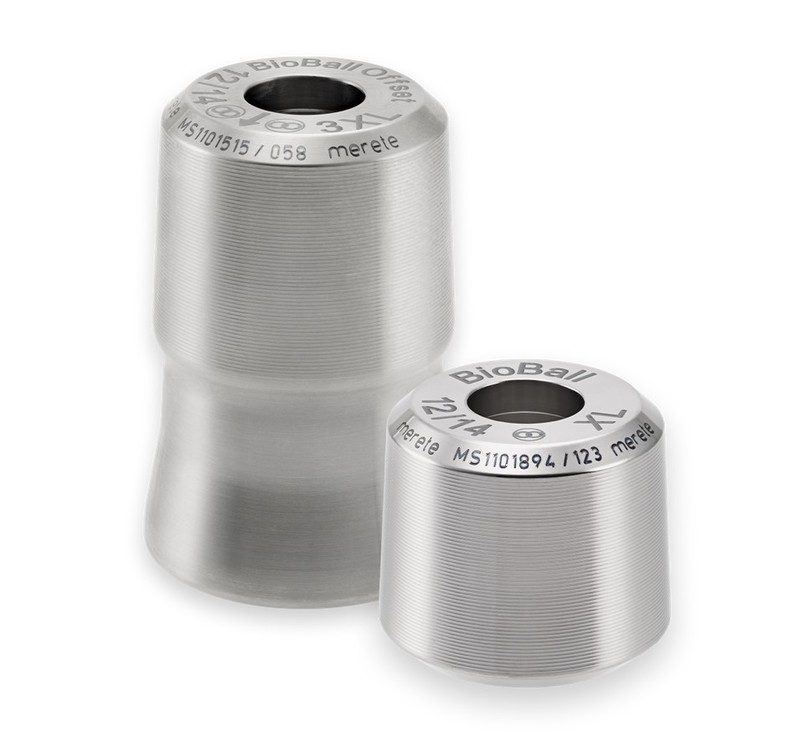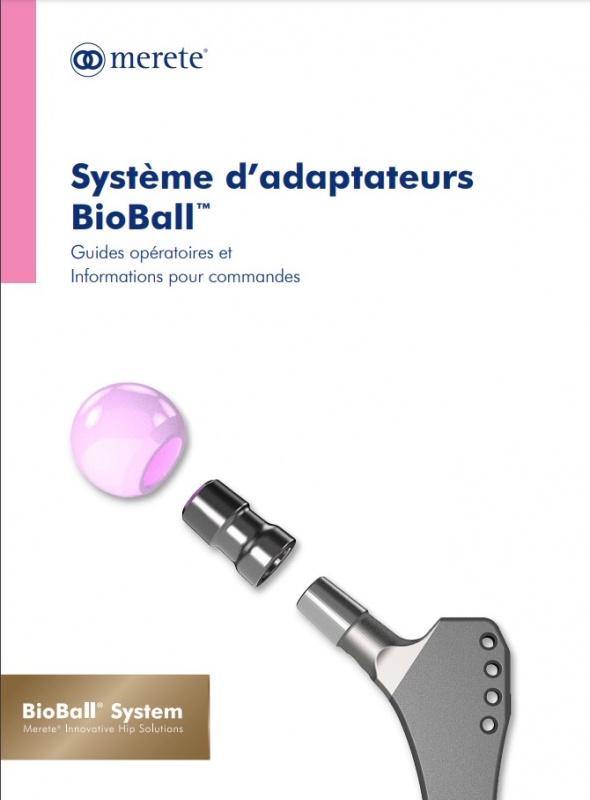.hd.jpg)
BioBall® System
Le système d’adaptateurs BioBall® est simple d’utilisation et sophistiqué permettant au chirurgien de corriger la longueur de col, l’antéversion/rétroversion et la latéralisation/médialisation de la tige in-situ en intra-opératoire.
Avantages

01
Minimiser les complexités opératoires (la tige reste en place) et la durée d’intervention.
02
Corriger l’antéversion / rétroversion et la latéralisation / médialisation d’une tige in-situ.
03
Corriger la longueur de col et ajuster la longueur de jambe lors de l’intervention.
Images

A propos
Le système d’adaptateurs BioBall® est simple d’utilisation et sophistiqué permettant au chirurgien de corriger la longueur de col, l’antéversion/rétroversion et la latéralisation/médialisation de la tige in-situ en intra-opératoire.
Le système BioBall® permet également de compenser les déformations légères à la surface du cône de la tige en place.
Les adaptateurs BioBall®, en alliage de titane, permettent de corriger la longueur de col, l’antéversion/rétroversion et la latéralisation/médialisation de la tige in-situ en intra-opératoire. Ce qui permet d’améliorer la marche et de réduire le risque de luxation.
Grâce à sa gamme d’offset et de cônes spéciaux, le système permet de répondre à des situations compliquées lors des arthroplasties primaires et de révisons de hanche.
Le système BioBall® permet également de compenser les déformations légères à la surface du cône de la tige en place.
Voir la bibliographie
BIBLIOGRAPHIE
[1] Emilie C. Dickinson, Kay Sellenschloh, Michael M. Morlock (2019). „Impact of stem taper damage on the fracture strength of ceramic heads with adapter sleeves“ Clinical Biomechanics, 63, 193–200.
[2] P. Weber, A. Steinbrück, A. C. Paulus, M.Woiczinski, F. Schmidtz, A. Fottner, V. Jansson (2017). „Gelenkteilwechsel in der Hüftarthroplastik. Was dürfen wir kombinieren?“ Orthopäde DOI 10.1007/s00132-016-3380-4
[3] Kock, H. J., Cho, C., Buhl, K., Hillmeier, J., Huber, FX. “Long-term outcome of a modular head adapter system in revision hip arthroplasty for multimorbid patients” Abstract Nr. 52, Vortrag EHS 2016 – München
[4] Bloch, B. and S. West (2015). Early results of the BioBall Taper Adaptor in revision total hip arthroplasty. British Hip Society Annual Meeting. London.
[5] Kock, H. J., C. Cho, F.-X. Huber and J. Hillmeier (2015). 10-year-results After Treatment Of Dislocating Total Hip Arthroplasty Using A Novel Head Adapter System. AAOS.
[6] Hoberg, M., C. Konrads, S. Huber, S. Reppenhagen, M. Walcher, A. Steinert, T. Barthel and M. Rudert (2015). „Outcome of a modular head-neck adapter system in revision hip arthroplasty.“ Arch Orthop Trauma Surg.
[7] Friedrich, M. J., S. Gravius, J. Schmolders, M. D. Wimmer and D. C. Wirtz (2014). „Biologisch azetabuläre Defektrekonstruktion beim Hüftendoprothesenwechsel mittels „Impaction Grafting“ und azetabulärem Rekonstruktionsring.“ Operative Orthopädie und Traumatologie 26(2): 126-140.
[8] Weber, P. and V. Jansson (2014). Teilwechsel an der Hüft. Was dürfen wir kombinieren? Orthopädische Nachrichten. Köln, Biermann Verlag GmbH. 01.2014.
[9]Helwig, P., L. Konstantinidis, A. Hirschmüller, A. Bernstein, O. Hauschild, N. P. Südkamp and B. G. Ochs (2013). „Modular sleeves with ceramic heads in isolated acetabular cup revision in younger patients-laboratory and experimental analysis of suitability and clinical outcomes.“ Int Orthop 37(1): 15-19.
[10] Jack, C. M., D. O. Molloy, W. L. Walter, B. A. Zicat and W. K. Walter (2013). „The use of ceramic-on-ceramic bearings in isolated revision of the acetabular component.“ Bone Joint J 95-B(3): 333-338.
[11] Vaishya, R., M. Sharma and R. R. Chaudhary (2013). „Bioball universal modular neck adapter as a salvage for failed revision total hip arthroplasty.“ Indian Journal of Orthopaedics 47(5): 519.
[12] Woelfle, J. V., C. R. Fraitzl, H. Reichel and D. Wernerus (2013). „Significantly Reduced Leg Length Discrepancy and Increased Femoral Offset by Application of a Head-Neck Adapter in Revision Total Hip Arthroplasty.“ J Arthroplasty.
[13] Perka, C., B. Fink, M. Millrose, U. Sentürk, M. Wagner, J. Schröder, H. Bail, R. Ascherl, A. Pruss, K. Thiele and C. Götze (2012). Revisionsendoprothetik. AE-Manual der Endoprothetik. L. Claes, P. Kirschner, C. Perka and M. Rudert, Springer Berlin Heidelberg: 441-587.
[14] Croce, A., M. Ometti and P. Dworschak (2011). „A580. Minimal Invasive Revision Surgery with Modular Neck Adaptors (Bioball).“ Journal of Bone & Joint Surgery, British Volume 93-B(SUPP IV): 422-422.
[15] Kretzer, J. P., R. Sonntag, J. Reinders, E. Jakubowitz, M. Thomsen and C. Heisel (2010). Fretting and Metal Release of Modular Neck Total Hip Arthroplasty. 56th Annual Meeting of the Orthopaedic Research Society. New Orleans.
[16] Dürr, H. R. (2009). „[The problem of fractures of ceramic heads. What should be done?].“ Orthopade 38(8): 698-703.
[17] Kretzer, J. P., E. Jakubowitz, M. Krachler, M. Thomsen and C. Heisel (2009). „Metal release and cor¬rosion effects of modular neck total hip arthroplasty.“ International Orthopaedics 33(6): 1531-1536.
[18] Fink, B. and A. Grossmann (2008). „[Technique of implantation of a cementless press-fit cup in revisions with severe bone defects].“ Oper Orthop Traumatol 20(2): 157-167.
[19] Kleffner, B., M. Morlock and R. Schröder (2008). Werkstoff-und designrelevante Aspekte von Pfannenrevisionsimplantaten. Revisionsendoprothetik der Hüftpfanne. D. Wirtz, C. Rader and H. Reichel, Springer Berlin Heidelberg: 201-229.
[20] Kircher, J., P. Bergschmidt, R. Bader, D. Kluess, E. Besser-Mahuzir, A. Leder and W. Mittelmeier (2007). „Die Bedeutung der Gleitpaarung beim jüngeren Endoprothesenpatienten.“ Der Orthopäde 36(4): 337-346.
[21] Bader, R., R. Barbano and W. Mittelmeier (2005). „Treatment of recurrent dislocation associated with impingement after revision total hip arthroplasty.“ Acta Orthop Belg 71(1): 98-101.
[22] Gradinger, R., R. Burkart and M. Goebel (2005). MML-System (ESKA-Implants). Modulare Revisions-endoprothetik des Hüftgelenks. P. Thümler, R. Forst and G. Zeiler. Heidelberg, Springer Medizin Verlag: 258-263.
[23] Kock, H. J., C. Niewöhner, J. Hillmeier and P. J. Meeder (2004). Frühergebnisse der Behandlung von Hüftprothesenluxationen mit einem modularen Steckkopfsystem bei multimorbiden Patienten. 171. Jahrestagu
[1] Emilie C. Dickinson, Kay Sellenschloh, Michael M. Morlock (2019). „Impact of stem taper damage on the fracture strength of ceramic heads with adapter sleeves“ Clinical Biomechanics, 63, 193–200.
[2] P. Weber, A. Steinbrück, A. C. Paulus, M.Woiczinski, F. Schmidtz, A. Fottner, V. Jansson (2017). „Gelenkteilwechsel in der Hüftarthroplastik. Was dürfen wir kombinieren?“ Orthopäde DOI 10.1007/s00132-016-3380-4
[3] Kock, H. J., Cho, C., Buhl, K., Hillmeier, J., Huber, FX. “Long-term outcome of a modular head adapter system in revision hip arthroplasty for multimorbid patients” Abstract Nr. 52, Vortrag EHS 2016 – München
[4] Bloch, B. and S. West (2015). Early results of the BioBall Taper Adaptor in revision total hip arthroplasty. British Hip Society Annual Meeting. London.
[5] Kock, H. J., C. Cho, F.-X. Huber and J. Hillmeier (2015). 10-year-results After Treatment Of Dislocating Total Hip Arthroplasty Using A Novel Head Adapter System. AAOS.
[6] Hoberg, M., C. Konrads, S. Huber, S. Reppenhagen, M. Walcher, A. Steinert, T. Barthel and M. Rudert (2015). „Outcome of a modular head-neck adapter system in revision hip arthroplasty.“ Arch Orthop Trauma Surg.
[7] Friedrich, M. J., S. Gravius, J. Schmolders, M. D. Wimmer and D. C. Wirtz (2014). „Biologisch azetabuläre Defektrekonstruktion beim Hüftendoprothesenwechsel mittels „Impaction Grafting“ und azetabulärem Rekonstruktionsring.“ Operative Orthopädie und Traumatologie 26(2): 126-140.
[8] Weber, P. and V. Jansson (2014). Teilwechsel an der Hüft. Was dürfen wir kombinieren? Orthopädische Nachrichten. Köln, Biermann Verlag GmbH. 01.2014.
[9]Helwig, P., L. Konstantinidis, A. Hirschmüller, A. Bernstein, O. Hauschild, N. P. Südkamp and B. G. Ochs (2013). „Modular sleeves with ceramic heads in isolated acetabular cup revision in younger patients-laboratory and experimental analysis of suitability and clinical outcomes.“ Int Orthop 37(1): 15-19.
[10] Jack, C. M., D. O. Molloy, W. L. Walter, B. A. Zicat and W. K. Walter (2013). „The use of ceramic-on-ceramic bearings in isolated revision of the acetabular component.“ Bone Joint J 95-B(3): 333-338.
[11] Vaishya, R., M. Sharma and R. R. Chaudhary (2013). „Bioball universal modular neck adapter as a salvage for failed revision total hip arthroplasty.“ Indian Journal of Orthopaedics 47(5): 519.
[12] Woelfle, J. V., C. R. Fraitzl, H. Reichel and D. Wernerus (2013). „Significantly Reduced Leg Length Discrepancy and Increased Femoral Offset by Application of a Head-Neck Adapter in Revision Total Hip Arthroplasty.“ J Arthroplasty.
[13] Perka, C., B. Fink, M. Millrose, U. Sentürk, M. Wagner, J. Schröder, H. Bail, R. Ascherl, A. Pruss, K. Thiele and C. Götze (2012). Revisionsendoprothetik. AE-Manual der Endoprothetik. L. Claes, P. Kirschner, C. Perka and M. Rudert, Springer Berlin Heidelberg: 441-587.
[14] Croce, A., M. Ometti and P. Dworschak (2011). „A580. Minimal Invasive Revision Surgery with Modular Neck Adaptors (Bioball).“ Journal of Bone & Joint Surgery, British Volume 93-B(SUPP IV): 422-422.
[15] Kretzer, J. P., R. Sonntag, J. Reinders, E. Jakubowitz, M. Thomsen and C. Heisel (2010). Fretting and Metal Release of Modular Neck Total Hip Arthroplasty. 56th Annual Meeting of the Orthopaedic Research Society. New Orleans.
[16] Dürr, H. R. (2009). „[The problem of fractures of ceramic heads. What should be done?].“ Orthopade 38(8): 698-703.
[17] Kretzer, J. P., E. Jakubowitz, M. Krachler, M. Thomsen and C. Heisel (2009). „Metal release and cor¬rosion effects of modular neck total hip arthroplasty.“ International Orthopaedics 33(6): 1531-1536.
[18] Fink, B. and A. Grossmann (2008). „[Technique of implantation of a cementless press-fit cup in revisions with severe bone defects].“ Oper Orthop Traumatol 20(2): 157-167.
[19] Kleffner, B., M. Morlock and R. Schröder (2008). Werkstoff-und designrelevante Aspekte von Pfannenrevisionsimplantaten. Revisionsendoprothetik der Hüftpfanne. D. Wirtz, C. Rader and H. Reichel, Springer Berlin Heidelberg: 201-229.
[20] Kircher, J., P. Bergschmidt, R. Bader, D. Kluess, E. Besser-Mahuzir, A. Leder and W. Mittelmeier (2007). „Die Bedeutung der Gleitpaarung beim jüngeren Endoprothesenpatienten.“ Der Orthopäde 36(4): 337-346.
[21] Bader, R., R. Barbano and W. Mittelmeier (2005). „Treatment of recurrent dislocation associated with impingement after revision total hip arthroplasty.“ Acta Orthop Belg 71(1): 98-101.
[22] Gradinger, R., R. Burkart and M. Goebel (2005). MML-System (ESKA-Implants). Modulare Revisions-endoprothetik des Hüftgelenks. P. Thümler, R. Forst and G. Zeiler. Heidelberg, Springer Medizin Verlag: 258-263.
[23] Kock, H. J., C. Niewöhner, J. Hillmeier and P. J. Meeder (2004). Frühergebnisse der Behandlung von Hüftprothesenluxationen mit einem modularen Steckkopfsystem bei multimorbiden Patienten. 171. Jahrestagu
Tailles
& Options
Clause De Non-Responsabilité
Veuillez noter que tous les produits ne sont pas disponibles et enregistrés sur tous les marchés. Veuillez contacter votre représentant commercial LimaCorporate pour toute information complémentaire.
BioBall® System est fabriqué par Merete GmbH et distribué par Lima France sas.
DiPHOS Nail est fabriqué par LSM-MED S.r.l. et distribué par Lima France sas.
BIOLOX® / BIOLOX®delta / BIOLOX OPTION® is a registered trademark of a company of the CeramTec Group, Germany.
BioBall® System est fabriqué par Merete GmbH et distribué par Lima France sas.
DiPHOS Nail est fabriqué par LSM-MED S.r.l. et distribué par Lima France sas.
BIOLOX® / BIOLOX®delta / BIOLOX OPTION® is a registered trademark of a company of the CeramTec Group, Germany.














.hd.jpg)

